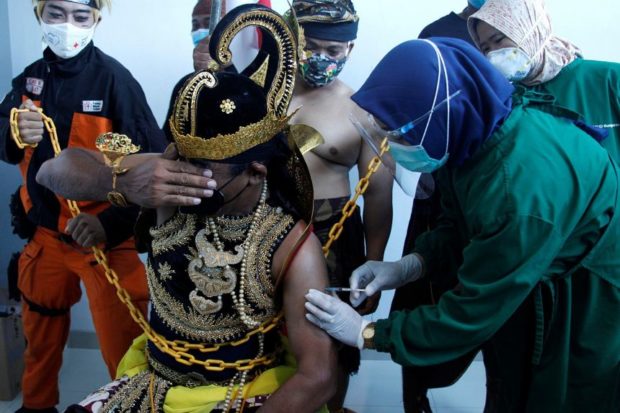
The Indonesian government has set an ambitious target of getting 181 million people vaccinated by March 2022. REUTERS via The Straits Times/Asia News Network
SINGAPORE — “Safe and halal”, the words screamed from a red backdrop as Indonesian President Joko Widodo settled into a chair in front of it and rolled up his sleeve to receive his first dose of the Covid-19 vaccine.
Cameras rolled live, and soon enough, photos and footage of the iconic moment began making their rounds on social media and news websites.
The message was more likely meant to calm nerves in the world’s most populous Muslim nation of 270 million people, with many questioning if the vaccine was safe to use and permissible under Islam.
With nearly a million cases and 27,000 deaths – and counting – the vaccine developed by Chinese drugmaker Sinovac Biotech appears the best bet to keep the health crisis under control. And the government is sparing no effort to convince Indonesians to get vaccinated even though BPOM, the country’s food and drug monitoring agency, rated the vaccine’s efficacy at just 65.3 per cent.
Mr Joko led by example, becoming the first to be inoculated.
The Indonesian Ulema Council, the top Muslim clerical body, also issued a religious edict deeming the vaccine as it halal or permissible.
At the launch of the mass vaccination program on Jan 13, ministers, clerics, celebrities, and even a vegetable seller were roped in for the publicity drive.
The government has set an ambitious target of getting 181 million people, or around 70 per cent of the population, vaccinated in 15 months, or by March 2022, to achieve herd immunity.
Some medical experts however expressed doubts about the timeline.
Dr Dicky Budiman, an epidemiologist at Griffith University in Australia, believed one and a half years to three years would be a more realistic timeline, considering the various challenges related to the country’s large population, sprawling geography, relatively weak infrastructure and human resources as well as “vaccine hesitancy”.
“Some people refuse to receive the vaccine, some doubt the vaccine’s efficacy and safety, and some will wait until there is a very clear and strong message from the government about the benefits and risks of the vaccine,” he told The Straits Times.
“Herd immunity is a long way to go, it needs to be supported by conditions to control the pandemic” which include continued testing and contact tracing, isolating and quarantining those exposed to the virus, he added.
But Dr Asok Kurup, who chairs the Academy of Medicine’s Chapter of Infectious Disease Physicians in Singapore, said Indonesia’s target was not implausible.
“It’s not far-fetched; Israel is achieving fantastic targets,” he said, citing the country which has vaccinated two million of its nine million population as of Jan 14. However, he was quick to note that “infrastructure and logistics are a lot different in Indonesia compared to Israel”.
“It’s not a silver bullet… and all other public health measures continue to be imperative,” he added.
Dr Kurup said vaccination offered another layer of protection. “Even though the Sinovac data on efficacy is still unclear, some protection as opposed to nothing merits use,” he said.
Only time will tell if Indonesia’s strategy works, with indicators such as a reduction in the number of cases as well as less utilization of healthcare resources over time.
Health Minister Budi Gunadi Sadikin on Thursday (Jan 21) told a business forum the president wanted the vaccination drive completed even earlier, within 12 months.
While the government might be perceived by some as rushing through the program, Dr Budi stressed vaccination was just one of the ways to deal with the pandemic, and that other health measures such as testing, isolating and strengthening the public healthcare system would continue.
“Vaccination is not only to protect ourselves, but also our families, neighbors, countrymen and all of humanity,” he said.